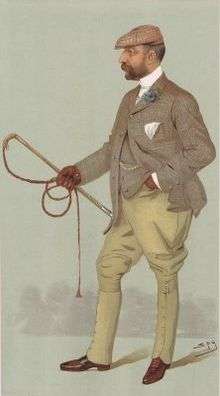Ernest Terah Hooley

Hooley as caricatured by Spy (Leslie Ward) in Vanity Fair, December 1896
Ernest Terah Hooley (5 February 1859 – 11 February 1947) was an English financier and developer of the Trafford Park industrial estate in the outskirts of Manchester.[1][2]
Early life
Hooley was born in Sneinton, Nottinghamshire, the only child of Terah Hooley, a lacemaker, and his wife Elizabeth. He joined his father's lace business and in 1881 married baker's daughter Annie Maria, with whom he had four daughters and three sons. Possibly with the assistance of an inheritance from his mother, Hooley bought Risley Hall in Derbyshire for £5,000 in 1888, and in the following year set himself up as a stockbroker in Nottingham.[1]
Business career
Hooley moved his business to London in 1896 and began to affect "a lavish lifestyle".[1] The rise in his fortunes coincided with the boom in bicycles that year, and until the 1898 slump in that business he had promoted 26 manufacturers with a total nominal capital of £18.6 million;[3] to impress investors he populated the boards of his companies with members of the aristocracy.[1] One of his most profitable deals was the purchase of the Trafford Park estate from Sir Humphrey Francis de Trafford in 1896. Hooley's original plan was to convert the park into a high-class residential area containing 500 grand villas, a racecourse, and an industrial fringe along the banks of the Manchester Ship Canal, but he was persuaded instead to develop the site as an industrial estate,[4] the first in the world[5] and still the largest in Europe.[6]
In 1895 he purchased Papworth Hall in Cambridgeshire.[1] He was appointed High Sheriff of Cambridgeshire and Huntingdonshire for 1897.[7]
In 1896, he purchased the 2,000 acre Anmer Hall Estate in Norfolk for £25,000 which he later resold to the Prince of Wales at cost.
In 1897 he was selected by the Conservative Party as their candidate to contest the parliamentary constituency of Ilkeston, Derbyshire at the next general election.[8] His bankruptcy the following year made him ineligible to stand however.[1][2]
Companies floated by E T Hooley and the gross profits of each promotion
- £5,000,000
- £1,250,000
- £2,500,000
- £100,000
- £250,000
- £375,000
- £650,000
- £900,000
- £100,000
- unknown
- unknown
- £200,000
- £800,000
- £200,000
- £ 75,000
- £100,000
- from the statement prepared by the Official Receiver of his estate.[9]
By 1911 he was in serious legal and financial difficulties. He spent a month in Brixton Gaol for contempt of court and later in the same year received a twelve-month sentence for obtaining money on false pretences as part of a land deal. In the following year he was judged bankrupt for the second time.[1] He re-entered business as an estate agent, but by 1921 was again bankrupt, and in 1922 was convicted of fraud and sentenced to three years imprisonment.[2] Following his release, Hooley returned to the business of property sales, continuing to work until his eighties. He was made bankrupt for a fourth time in 1939.[2]
Hooley died at Long Eaton, Derbyshire, aged 88.[2]
References
Notes
- 1 2 3 4 5 6 7 Oppenheimer, P. M.; Ryan, Janette (rev.) (2004), "Hooley, Ernest Terah (1859–1947)", Oxford Dictionary of National Biography (online ed.), Oxford University Press, retrieved 4 October 2010 (subscription or UK public library membership required)
- 1 2 3 4 5 "Death Of Mr. E. T. Hooley", The Times, 13 February 1947, p. 2
- ↑ Farnie (1980), p. 120
- ↑ Farnie (1980), pp. 120–121
- ↑ Nicholls (1996), p. xiii
- ↑ "Trafford Park Masterplan", Trafford Council, October 2008, retrieved 4 October 2010
- ↑ The London Gazette: no. 26828, p. 1238, 2 March 1897, retrieved 22 February 2009
- ↑ "Election Intelligence", The Times, 4 March 1897, p. 6
- ↑ page 5 Coventry Herald, 13 May 1904 (findmypast.com The British Newspaper Archive)
Bibliography